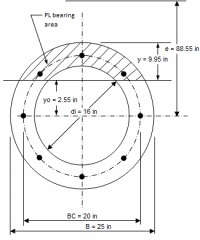CIRCBASE.xls

Description
"CIRCBASE" --- STEEL COLUMN CIRCULAR BASE PLATE ANALYSIS
Program Description:
"CIRCBASE" is a spreadsheet program written in MS-Excel for the purpose of analysis of steel column base plates. Specifically, pipe columns base plates may be subjected to axial loads (compression only), with or without column bending, plus shear. Base plate bearing pressure is checked as well as bolt tension, if applicable. If shear is present, bolt shear as well as interaction of bolt tension and shear, if applicable, are calculated. Finally, a propoesed base plate thickness is is checked.
This program is a workbook consisting of two (2) worksheets, described as follows:
Doc - This documentation sheet
Complete method - Circular base plate analysis
Program Assumptions and Limitations:
1. This program follows the procedures and guidelines of "Design of Monopole Bases", by Daniel Horn, P.E.
2. This program follows the procedures and guidelines of the AISC 9th Edition Allowable Stress (ASD) Manual (2nd Revision, 1995) for round hollow structural tube & column base plates subjected to flexure.
3. For steel interaction of anchor bolt tension and shear, this program follows:
Appendix D of ACI 318-02, "Building Code Requirements For Structural Concrete"
4. For concrete bearing, this program follows:
Section 10.17 of ACI 318-02, "Building Code Requirements For Structural Concrete"
5. User has option to take out some of the total shear though friction between column base and grout based on column dead load and coefficient of friction, thus reducing amount of shear to be taken by anchor bolts.
6. Additional assumptions used in this program are as follows:
a. The column is centered on a circular base plate in both directions.
b. The column & base plate are centered on a round pedestal in both directions.
b. Axial column load, 'P' > 0 for the case with moment.
7. This program contains numerous “comment boxes” which contain a wide variety of information including explanations of input or output items, equations used, data tables, etc. (Note: presence of a “comment box” is denoted by a “red triangle” in the upper right-hand corner of a cell. Merely move the mouse pointer to the desired cell to view the contents of that particular "comment box".)
8. For the addition of gusset plates to the baseplate, this program derives the baseplate moments from "Theory of Plates and Shells", by S. Tomonshenko. (1st Edition, 1940)
a. Table 26 - Deflection & Bending Moments for a Uniformly Loaded Plate with Two Opposite Edges
Simply Supported, the Third Edge Free and the Fourth is Built In (Page 218)
Calculation Reference
AISC 9th Edition Allowable Stress (ASD) Manual
ACI 318-02 Building Code Requirements For Structural Concrete
Calculation Preview
Full download access to any calculation is available to users with a paid or awarded subscription (XLC Pro).
Subscriptions are free to contributors to the site, alternatively they can be purchased.
Click here for information on subscriptions.
This spreadsheet for a circular baseplate calculation is very helpful to me regarding a project I'm 'under the gun' for at present. If anyone has time to answer one clarification, I would appreciate it:
My past experience has been with calculating embedded light pole foundations (caisson type pier footings). The iterative process is similar to that employed with embedded foundations to determine the requisite footing depth below grade.
My question regarding the circular baseplate program is trying to determine if/where the program determines the requisite concrete thickness and minimum bolt embedment. Could someone clarify that for me? I'm wondering if qcalc is related to this?
I've been reading through the references provided, trying to tune-in on that area, but haven't had a lot of luck so far.
Thanks.
mukesh
